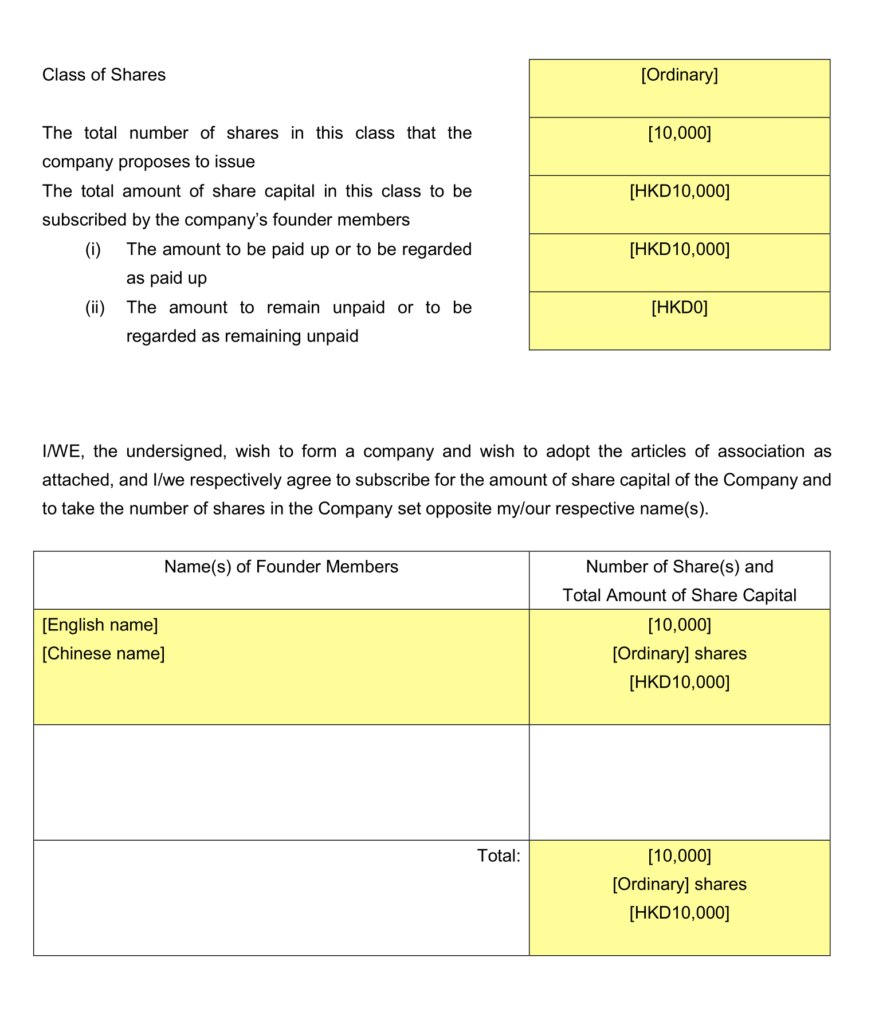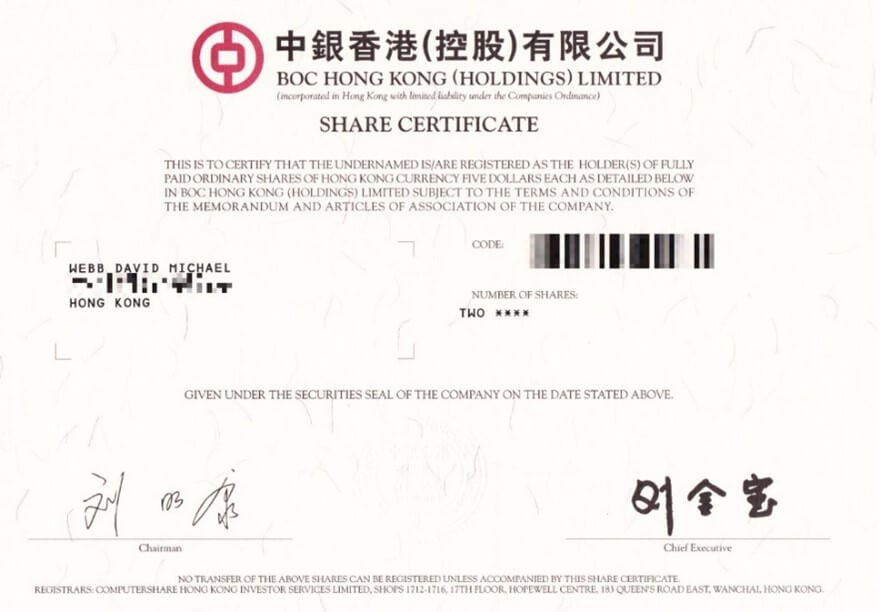The Articles of Association are the written regulations that govern the internal rules and governance of a company. The Hong Kong Companies Ordinance has specific legal requirements on the Articles of Association for Hong Kong companies, and has included a sample Article of Association anyone can use as a template and adjust to fit their company’s needs.
Model Articles of Association for Private Limited Companies
Model Articles of Association for Private Companies
In this article, we’ll go over key sections of the sample Articles of Association, provided by the Companies Registry, that you will deal with the most often in your company’s operation and break them down.
Part A
Mandatory articles
These items describe the basic structure of the company, including the company name, the liabilities and contributions of its members, and the structure of its share capital.
Item 1
Company name
This section of the Articles of Association states the Chinese and/or English names of the company that this document governs, according to the business registration document created when the company was incorporated.
Items 2 & 3
Members’ liabilities and contributions
This section states that the liability of the company members is limited to any amount unpaid on the shares held by the members. This means that the money a bankrupt company owes can only be sourced from the company’s coffers, and is what the “Limited” part of limited company means.
Item 4
Share capital
This section goes over the company shares, in particular, the total amount of shares to be issued, the class of the shares issued, and the initial distribution of the issued shares. The names of the founding members of the company and the number of shares issued to each founding member is listed here.
The sample Articles of Association only lists ordinary shares, but if a company needs more than one class of shares, and with special rights attached to the shares, the share classes shown in the sample articles would not be adequate. Companies with complex share structures and share classes should engage a lawyer to draft their articles of association according to the needs of the company.

Part B
Other Articles
The other articles under this part describe the powers of the company directors and their officers, how decisions are made, how meetings are organized and run, how shares work, and how changes to the company are made. We cover the most essential sections here.
Powers of the directors and the company secretary
This section covers the powers, rights, and procedures of company directors and the company secretary of the company.
Item 3
Directors’ general authority
The company directors have full authority to manage the company’s business, and any alteration to the articles do not affect the company director’s prior actions.
Item 4
Members’ reserve power (The special resolution)
Although the directors have general authority, the shareholders, through a special resolution, can force the company directors to take specific actions, or restrain the directors from taking certain actions. The special resolution cannot, however, invalidate past actions taken by the directors.
Item 5
Directors may delegate
This section gives the company directors the authority to delegate any of their powers granted by the articles to other officers. The directors may even delegate the authority to delegate powers to others, usually the company secretary. Just as they have the power to delegate these powers, they also have the ability to remove said powers from these other officers.
Decision-taking by Directors
Item 8
Calling directors meetings
Any of the company directors have authority to call a directors’ meeting by providing notice to all the other directors, or by authorizing the company secretary to provide notice to all directors. The notice provided to the directors should specify the details of the meeting, such as the proposed date, time, and location of the meeting. The notice does not need to be in written form. Director meetings can be called for any number of reasons, but are often called for performance reviews, Annual General Meetings, and to vote on company motions.
Item 9
Participation in directors’ meetings
Directors can participate in directors’ meetings in any mode of communication or location, meaning that directors attending a meeting remotely would have the same effect as attending in person.
Item 10
Quorum for directors’ meetings
A quorum is defined as the minimum number of directors required in attendance for the directors’ meeting to be considered valid. The sample Articles of Association sets the minimum number of directors for quorum to be reached to two, which can be changed in your own articles of association. If the company has only one director, then that director is adequate for quorum and decisions can be made solely by that director.
Item 11
Meetings if quorum is not reached
If quorum has not been reached, then no decisions or proposals can be taken or accepted. The only decisions allowed to be taken without quorum are to appoint additional directors or call a general meeting so that the shareholders can appoint additional directors so that quorum can be reached.
Items 12 & 13
Chairing of directors’ meetings and chairperson’s casting vote
The directors can appoint a director to serve as the chairperson for the meeting. If the appointed chairperson is absent or unwilling to chair the meeting within 10 minutes of the start time, the participating directors can appoint another chairperson as a replacement. A chairperson’s role is to direct meeting discussions to ensure all target topics have been covered, and to manage voting for decisions when quorum is reached.
In the event of a stalemate when a proposal receives an equal number of votes on both sides, the chairperson can cast the deciding vote to break the stalemate.
Item 14
Conflicts of interest
Under section 536 of the Hong Kong Companies Ordinance, when a company director has a personal interest in any proposals or transactions discussed in the directors’ meeting, the director must disclose the nature and extent of their interest to the other directors. The same director is then prohibited from voting on or being counted to reach quorum.
Directors are still allowed to enter into contracts or transactions with the company, but a director of the company cannot also fulfill the role of the auditor.
Item 17
Records of decisions made to be kept
Under the Companies Ordinance, the directors of the company must ensure that there is a written record of every decision made by the directors for at least 10 years from the date of the decision.
For companies with only 1 director, the sole director must still maintain a written record of the decisions made. For decisions made through written resolutions, the written resolution can be considered as the written record.
Appointment, Resignation, and Termination of Directors
Item 20
Appointment of directors
A person can be appointed as a director if they are willing and legally permitted to act as a director. Said person must be at least 18 years of age, and can be appointed by either an ordinary resolution or by the decision of the directors.
A director appointed by an ordinary resolution can stay in office indefinitely, but a director that has been appointed by the decision of the directors must retire either at the next AGM or within 9 months after the end of the company’s financial year end, and seek reappointment.
Item 22
Termination of directors
A director is terminated if they become prohibited by the law from being a director, file for bankruptcy, become mentally incapacitated, resign, absent from directors meetings without permission for more than 6 months, or they are removed from office by an ordinary resolution.
Part 4
Annual General Meetings (AGM) and General meetings

Item 28
General meetings and shareholders meetings
The sample Articles of Association states that companies are required to hold an annual general meeting each financial year to comply with the AGM requirements from the Companies Ordinance.
The directors of the company also have the right to call a general meeting for the shareholders if necessary, just as the shareholders also have the right to request the directors to call a general meeting. If the directors refuse to call the general meeting, the shareholders have the right, under the Companies Ordinance, to call the general meeting themselves if they hold more than half of the voting rights.
Item 29
Notice of general meetings and shareholder meetings
To call an AGM (annual general meeting), a written notice of at least 21 days must be provided. A general meeting of the shareholders must provide a written notice of at least 14 days. The day the notice is served and the day of the meeting do not count towards the 21 days or the 14 days.
The notice should be provided to every director and shareholder of the company. The auditor should be provided a copy of the notice. If notice to anyone was accidentally omitted, the meeting is still considered valid.
The notice of the meeting should include the following:
- Date and time of the meeting
- Format details of the meeting, whether it will be held at a physical venue or virtually
- General nature of the items to be discussed
- The type of meeting, whether it is an AGM (annual general meeting) or a general meeting
- Information on any resolutions to be discussed
- Statement notifying the members of their rights to appoint a proxy
Item 33
Quorum for general meetings
A quorum is the minimum number of shareholders required in attendance for the general meeting to be considered valid. The sample Articles of Association by default sets the minimum shareholders in attendance for quorum of general meetings to 2 shareholders present, with virtual or physical presence. If the company has only 1 shareholder, then that sole shareholder alone constitutes a quorum. Without establishing a quorum, the only action that can be taken is the selection of a chairperson for the meeting.
Item 36
Adjournment
The act of adjourning a meeting is to postpone the meeting to another date or time. If a quorum is not established within 30 minutes of the scheduled time of the general meeting called by the directors, the meeting will be adjourned. If the meeting was called by the shareholders and no quorum is not established within 30 minutes, the meeting will be dissolved.
If the meeting is adjourned, the directors must determine the date, time, and location of the adjourned meeting. If during the next adjourned meeting, a quorum still has not been established, the members present at the meeting will be considered a quorum.
Item 37
Voting at general meetings
Resolutions at a general meeting can be voted on by a show of hands. A poll can be demanded by either the chairperson, at least 2 shareholders, or a member that has at least 5% of the total voting rights. During a vote, if there is a tie, the chairperson of the meeting will have a second deciding vote.
The number of votes each member has is different depending on whether the vote is by a show of hands, or if a poll is demanded. When voting is carried out by a show of hands, each member present has 1 vote each. When voting is carried out by a poll, each member present has one vote for each share they hold.
Item 43
Appointing a proxy for a general meeting
If a shareholder wishes to appoint a proxy to attend and act on behalf of them at the general meeting, a written proxy notice must be delivered at least 48 hours before the meeting.
The proxy notice must be authenticated or signed on behalf of the shareholder and should include the following information:
- The shareholder’s name
- The shareholder’s address
- The appointed proxy’s identity
- The general meeting that the proxy will attend
Under section 605 of the Companies Ordinance, if the shareholder appoints a proxy but still attends the general meeting, then the proxy’s authority to act is revoked.
Issuance, transfers, and allotment of shares

Item 49
Issue of shares
For shares to be issued to shareholders, the shares must be fully paid for, and the company must notify the Companies Registry within one month of the issuance by submitting a Return of Allotment.
Item 54
Transfer of shares
Shares of the company can be transferred using a document called the [instrument of transfer], of which the company can keep a copy afterwards. If the shares are transferred to a new shareholder, the transfer will not come into effect until the new shareholder’s name has been entered into the register of members.
The directors of the company have the power to refuse a transfer of shares, but the directors must provide a statement of reasons for the refusal. Reasons for the refusal may include improper transfer procedures or suspicion of fraud. In the event of a shareholder’s death, the company can recognise the legal representative of the deceased shareholder to hold the title of the shares.
Item 63
Allotment of shares
The company may allot new shares of the company with the approval of the shareholders by resolution.
Concerning Dividends
Items 64 to 69
Declaring dividends
Under the Companies Ordinance, dividends can only be paid out of the profits of the company. The declaration of dividends can be carried out at a general meeting of the members, and the dividends must be paid based on each member’s shareholding on the date of the resolution to declare dividends. A shareholder also has the right to waive their right to their dividends.
Dividends can take the form of other non-cash assets, which the company can pay out with the approval of an ordinary resolution.
Conclusion
The Articles of Association plays a crucial role in governing the internal rules and operations of a company in Hong Kong. These written regulations, as required by the Hong Kong Companies Ordinance, provide a framework for the company’s structure, decision-making processes, and relationships among its members.
The above sections have highlighted the key aspects of the sample Articles of Association provided by the Companies Registry. However, companies with unique needs or complex share structures should seek legal guidance to draft tailored Articles that suit the company’s needs.










